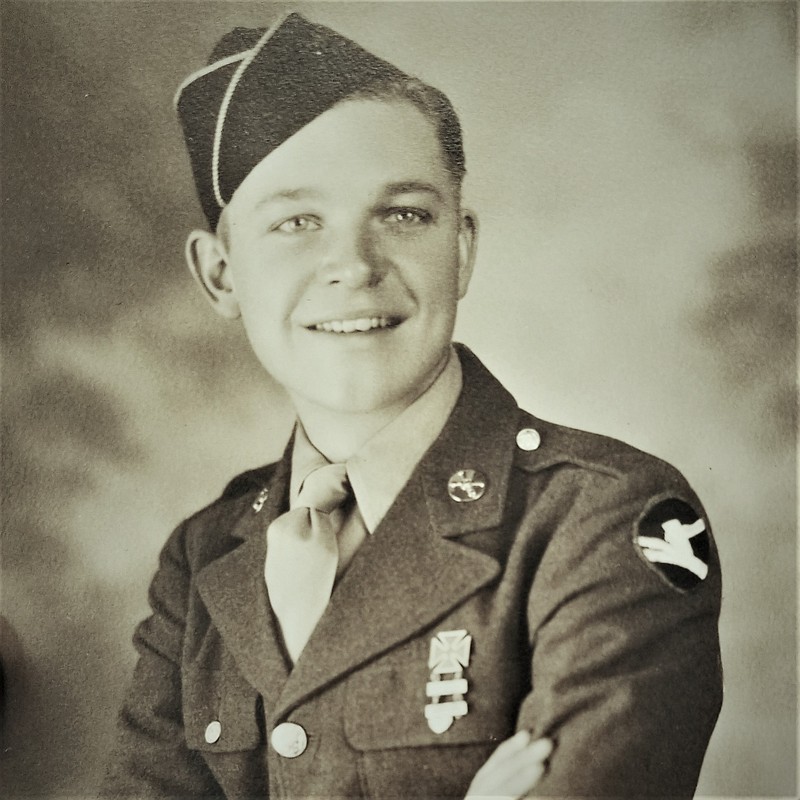The harsh reality for Herb Siebert when he approached his graduation from Cleveland High School in St. Louis during the height of World War II was that it was likely only a matter of time before he was drawn into the military. Shortly before his graduation in May 1943, he received his draft notice. A few weeks later, the 18-year-old traveled to nearby Jefferson Barracks for his induction into the U.S. Army.
"That all happened right in the middle of the war and I didn't want to rush into the service, but I knew I would go when my time came," the veteran said.
Following his entry into active service on July 28, 1943, he was sent to Camp Wallace, Texas, for his basic training. It was here, Siebert noted, that he and many of his fellow trainees received instruction to prepare them to serve in anti-aircraft artillery units.
"When we finished our training that fall, that's when they sent us down to Camp Claiborne (Louisiana) and transferred us into the infantry," he recalled. "That's also the place where I became a member of Company E, 335th Regiment of the 84th Division."
For the next year, Siebert endured the heat of the Bayou State while participating in maneuvers and battle simulations and learning to operate a number of different weapons. During this training period, he began as an assistant gunner but eventually was assigned as primary gunner using a .30-caliber machine gun.
In late September 1944, the division traveled to Camp Kilmer New Jersey, to board troop ships that would deliver them to the war raging in Europe. Several days later, they arrived in England and, in early November, were entering France through Omaha Beach - the site of the deadly D-Day invasion only five months earlier.
"We got off the LSTs (landing ship tanks) that brought us to Omaha Beach, and I thought they'd bring trucks to take us to our next stop," he laughed. "Instead, we must have walked 20 miles, and I was wearing new boots." Smiling, he added, "I had blisters on my heels, and when we finally got there, we pitched our tents in the rain and it was miserable."
A booklet about the 84th Division published in the Stars and Stripes (military newspaper) during the war noted, "Wasting little time, (they) sped through France and Belgium into Holland. Rarely had a division been moved from the States to the flaming Western Front with such speed as the 84th's.
"Within a week after the division CP (command post) was set up, (they) were attacking one of the strongest sectors of the Siegfried Line."
Siebert said, "On Nov. 29, we were pinned down overnight by machine gun fire coming from a bunker. The following morning they ordered us to attack the bunker and I expected return fire, but by the time we reached it, it had been abandoned."
As mid-December 1944 arrived, the last major German offensive of the war unfolded - the Battle of the Bulge. Handwritten notes maintained by Siebert record that on Dec. 17 his company "repulsed heavy German night attack and destroyed an entire enemy battalion." Three days later, they were "relieved by the 102nd (Division) and motored to (Marche-en-Famenne), Belgium."
The notes go on to describe Christmas Day being spent in a barn followed by movement to a different assembly area to relieve British troops a few days later. However, the following week, a combat injury would remove Siebert from his unit for nearly a month.
"On Jan. 9 (1945), we had to move on the offensive once again and I remember we set up our machine gun on a road firing into the woods to provide cover for our riflemen to move in," Siebert explained. "That must not have been too bright because the ground around us was white with snow and we probably stuck out like store thumbs in our olive drab uniforms."
As Siebert recalled, the German soldiers had concealed a machine gun nest and soon began firing upon him and his assistant gunner.
"We got up to run to higher ground, and that's when I felt a sting on my arm," he said. "I was shot through the upper left arm, but fortunately it wasn't too serious a wound."
He was evacuated to a field hospital for treatment and when he was able to return to his unit, the Battle of the Bulge was over. Weeks later, the war in Europe ended and Siebert remained in Germany until January 1946 as a member of the occupational forces. On Feb. 11, 1946, he received his discharge from the U.S. Army at Jefferson Barracks, Missouri.
In the years after the war, Siebert was employed by the McDonnell Douglas Corporation, retiring in 1987 after 30 years with the company. He and his wife, Brenda, now reside in a retirement community in his native St. Louis.
Plain spoken about his service in World War II, the Purple Heart recipient avoids any sensational descriptions of his own service that might diminish the contributions of the brave soldiers with whom he served. Despite having survived the frigid European winter and being shot in combat, the veteran still maintains mirthful reflections of his wartime experiences.
"It's been so long that many of my memories of the war have left me but I remember that they usually fed us pretty good over there," he affirmed. Smiling, he added, "You know how us GI's are - you could feed us steak every night, and we'd still complain."
Jeremy P. Amick writes on behalf of the Silver Star Families of America.

